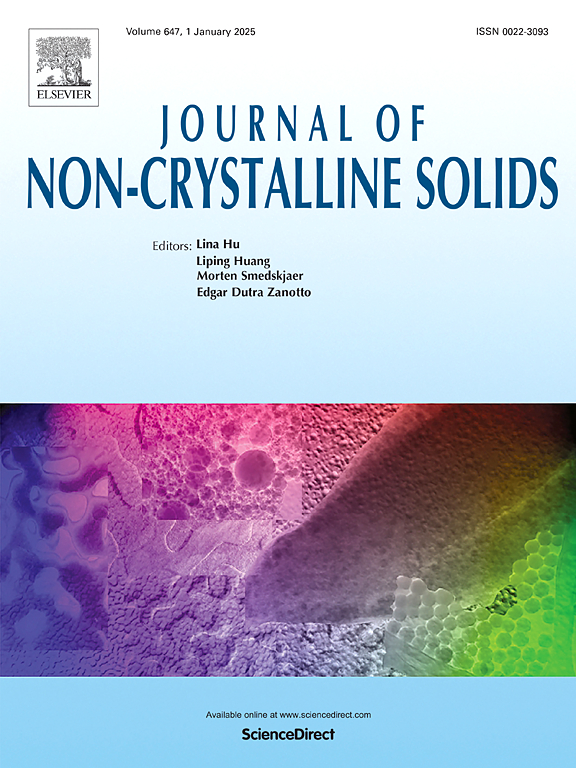Luminescence properties and Judd-Ofelt theory analysis of Tb3+-Sm3+ co-doped glass ceramics containing Sr5F(PO4)3
IF 3.2
3区 材料科学
Q1 MATERIALS SCIENCE, CERAMICS
引用次数: 0
Abstract
Tb3+-Sm3+ co-doped glass ceramics containing Sr5F(PO4)3 phase were synthesized using the melting-curing-crystallization method. The best heat treatment condition for glass ceramics was determined to be at 750 °C for 1.5 h through the use of differential scanning calorimetry (DSC), X-ray diffraction (XRD), and transmittance curve analysis. With the Judd-Ofelt theory, the Judd-Ofelt strength parameters Ωλ (λ=2,4,6) for precursor glasses and glass ceramics were calculated. Fluorescence spectroscopy was used to study the optical properties of Tb3+-Sm3+ co-doped containing Sr5F(PO4)3 glass ceramics. The results demonstrated a significant enhancement in the luminescence performance of Sr5F(PO4)3 crystalline glass ceramics compared to the precursor glass. Fluorescence lifetimes and Dexter's theory demonstrate energy transfer from Tb3+ to Sm3+. The luminescent color of glass ceramics can be altered by varying the concentration of Sm3+ doping. The Tb3+-Sm3+ co-doped Sr5F(PO4)3 phase glass ceramics exhibit promising potential for application in the field of W-LEDs.
含 Sr5F(PO4)3 的 Tb3+-Sm3+ 共掺玻璃陶瓷的发光特性和 Judd-Ofelt 理论分析
采用熔融-固化-结晶法合成了含有 Sr5F(PO4)3 相的 Tb3+-Sm3+ 共掺玻璃陶瓷。通过使用差示扫描量热法(DSC)、X 射线衍射法(XRD)和透射率曲线分析,确定玻璃陶瓷的最佳热处理条件为 750 °C 下 1.5 小时。根据 Judd-Ofelt 理论,计算了前驱体玻璃和玻璃陶瓷的 Judd-Ofelt 强度参数 Ωλ (λ=2,4,6) 。荧光光谱法用于研究 Tb3+-Sm3+ 共掺含 Sr5F(PO4)3 玻璃陶瓷的光学特性。结果表明,与前驱体玻璃相比,Sr5F(PO4)3 结晶玻璃陶瓷的发光性能显著增强。荧光寿命和 Dexter 理论证明了从 Tb3+ 到 Sm3+ 的能量转移。玻璃陶瓷的发光颜色可以通过改变 Sm3+ 的掺杂浓度来改变。Tb3+-Sm3+ 共掺杂 Sr5F(PO4)3 相玻璃陶瓷在 W-LED 领域的应用前景十分广阔。
本文章由计算机程序翻译,如有差异,请以英文原文为准。
求助全文
约1分钟内获得全文
求助全文
来源期刊

Journal of Non-crystalline Solids
工程技术-材料科学:硅酸盐
CiteScore
6.50
自引率
11.40%
发文量
576
审稿时长
35 days
期刊介绍:
The Journal of Non-Crystalline Solids publishes review articles, research papers, and Letters to the Editor on amorphous and glassy materials, including inorganic, organic, polymeric, hybrid and metallic systems. Papers on partially glassy materials, such as glass-ceramics and glass-matrix composites, and papers involving the liquid state are also included in so far as the properties of the liquid are relevant for the formation of the solid.
In all cases the papers must demonstrate both novelty and importance to the field, by way of significant advances in understanding or application of non-crystalline solids; in the case of Letters, a compelling case must also be made for expedited handling.
 求助内容:
求助内容: 应助结果提醒方式:
应助结果提醒方式:


